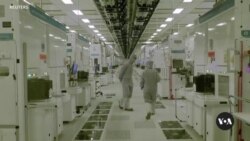As Asia-Pacific Economic Cooperation, or APEC countries, get set to meet in San Francisco, how many of them might benefit from U.S. companies shifting away from China?
Welcome to VOA Asia Weekly. I'm Chris Casquejo in Washington. That story is just ahead, but first, making headlines:
U.S. Secretary of State Antony Blinken met with Group of Seven foreign ministers on Tuesday for two days of talks in Japan. The Hamas-Israel war was on the agenda. The G-7 foreign ministers called for humanitarian pauses and corridors to allow for aid delivery and the release of hostages taken by Hamas.
“It's also clear that Israel cannot occupy Gaza.”
Following the G-7 summit, Blinken met with senior South Korean leaders to discuss military cooperation between North Korea and Russia. He and the South Korean foreign minister urged China — North Korea’s main ally and economic lifeline — to take a greater role in pulling the North back from destabilizing behavior.
Australian Prime Minister Anthony Albanese called for the “full resumption of free and unimpeded trade” with China in a meeting Tuesday with Chinese Premier Li Qiang. Albanese met with Chinese President Xi Jinping on Monday, making him the first Australian leader to visit China since 2016. Xi said relations between the two countries are “on the right path.”
Two significant earthquakes hit Nepal in 3 days. On Monday, a magnitude 5.2 earthquake injured three people in the same location as last Friday’s tremor. That 6.4 magnitude quake killed at least 153 people and injured more than 339 in the Jajarkot region.
Tokyo authorities held a missile evacuation drill on Monday to help residents prepare amid growing concerns over North Korea’s test launches of ballistic missiles. Japan has conducted more than a dozen such drills nationwide this year, with Monday’s drill being the first one in Tokyo since 2018.
As they prepare to meet in San Francisco, many member economies of the Asia-Pacific Economic Cooperation bloc may profit as U.S. companies move production out of China under a practice known as “friendshoring.” VOA’s Jessica Stone explains what that means.
For decades, China has served as the world’s factory, as recently as 2020 contributing nearly double the total manufacturing output of the United States. Low wages, a well-developed infrastructure and government support all contributed to its success.
Supply chain consultant Rosemary Coates says these days many CEOs don’t see China as a factory but as a risk. And they’re willing to pay more to avoid it.
“Now, the executives that I'm working with not only look at dollars and cents, but they're evaluating global risk, geopolitical risk.”
Coates says the combination of the pandemic supply chain disruption and Beijing’s zero-covid shutdowns has prompted some American executives to consider changing the way they look at manufacturing, choosing to work with countries that have a solid allied relationship with the U.S.
It’s a trend, known as “friend shoring.” And it’s a policy taking root among some of the 21 members of the Asia-Pacific Economic Cooperation, or APEC.
Bloomberg data shows that cost-conscious U.S. apparel-makers started moving out of China into Vietnam, Bangladesh and Indonesia even before trade tensions with Beijing began in 2017. In the CHIPS Act of 2022, the Biden administration offered $500 million over five years to help modernize and secure new semiconductor supply chains.
Last month, semi-conductor maker Amkor Technology announced a new test and assembly plant in Vietnam.
Shoemaker Nike has also steadily shifted production from China to Southeast Asia for the past decade.
But trade analyst Steven Okun says not all of China’s neighbors are ready to welcome US companies and their factories.
"You may want to diversify out of China. You may want to say, 'I want to make my supply chain more resilient,' but where are you going to go, because you can’t take all of China and put it into Vietnam. You can’t put it into Indonesia. You can’t put it into India, so you are going to see some certainly some diversification to create these resilient supply chains.
After all, say trade analysts, China has spent years building its infrastructure, labor pool, and regulations to become the world’s factory. And it’s still the best place to make things for the Chinese market.
Jessica Stone, VOA News.
Visit voanews.com for the most up-to-date stories.
I’m Chris Casquejo.
Finally, it’s not goodbye, but farewell for now, giant pandas.
Crowds gathered as the Smithsonian National Zoo in D.C. bid adieu to its three giant pandas Wednesday. They later departed on a plane back to China.
Thanks for watching VOA Asia Weekly.












